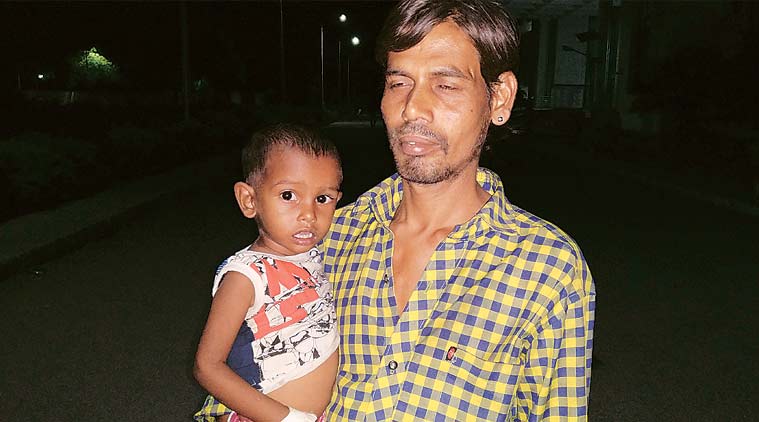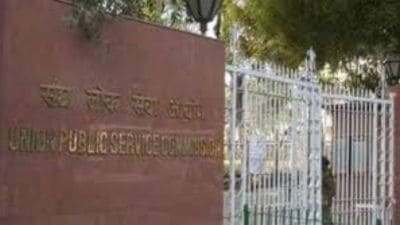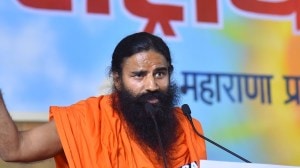- India
- International
Karnataka Assembly elections: Siddaramaiah govt fought malnutrition in backward Raichur, now Congress hopes to reap benefits
Until 2012, people in Raichur had to go to neighbouring Gulbarga district to treat malnourished children, but facilities are now available in every taluk, besides the 20-bed referral centre for nutritional rehabilitation at RIMS.
 Chand Pasha with son Hassan at Raichur hospital.
Chand Pasha with son Hassan at Raichur hospital.
“I look around, and I see all these babies who look like newborns when they are actually one or two years old,” said construction worker Chand Pasha, 30, outside the Nutritional Rehabilitation Centre (NRC) at Raichur Institute of Medical Sciences (RIMS).
Pasha’s two-year-old son Hassan is among 11 babies admitted at the 20-bed nutrition centre at the main government hospital in the impoverished Raichur district of northern Karnataka. At two, Hassan weighs only 7 kg when he should be at least 10 kg.
Closer to Telangana capital Hyderabad than state capital Bengaluru, Raichur, one of the most impoverished regions of Karnataka, has often in the past hit the headlines for deaths of children due to malnourishment, and absence of awareness and childcare facilities. In 2011, the state Women and Child Welfare department had reported death of 2,600 children in the region in the preceding two years due to malnourishment, forcing the then BJP government to introduce eggs at anganwadis for severely under-nourished kids.
But one of the major achievements of the Siddaramaiah-led Congress government in Karnataka over the last five years is seen as addressing issues around malnutrition that dogged backward districts such as Raichur.
While mothers and babies were crammed into a 10-bed ayurveda hospital at the district hospital premises, allotted two pairs to a bed and and regularly spilled over into the hospital yard before 2013, over the last five years the nutrition centre was moved to a wing on the fourth floor of a shiny, new 500-bed hospital facility. This was created at the state-run Raichur Medical College to replace the decrepit, 70-year-old district hospital, which had until then been the fulcrum of all medical care.

On the human development index for Karnataka, Raichur district is at the bottom. Nearly 75 per cent of children between six months and five years of age are anaemic, with 20 per cent of them being severely anaemic. Nearly 25 per cent women marry below age 18, and 58 per cent women between 15 and 49 years are anaemic.
Infant mortality rate in the district is 67 per 1,000 live births, nearly double the state figure of 35 (as per the 2011 census) and maternal mortality is at 244 per 1,000 compared to Karnataka’s 144.
Child marriages, poverty, lack of education and inability of parents to give attention to children under the burden of poverty are cited by experts as prime reasons for the high incidence malnourishment.
“This is a part of Karnataka where the weather is harsh, the land hard, and the people poor. Women have to work to supplement earnings at home — they work through their pregnancies, and within a week of delivery are at work again. There is little time to look after nutrition,” said Sangamma Maradi, who works on improving nutrition habits in villages of Raichur’s Devadurga taluk, one of the most impoverished.
The state government has scaled up the battle against malnutrition through multi-pronged strategies such as providing for eggs and milk at anganwadi centres for children across the state, increasing awareness on importance of nutrition and facilities available such as NRC for care in extreme situations, payment of stipends to mothers at Rs 100 per day over 14 days they are expected to spend at NRC to help their children gain weight, among others.
“The state government is providing everything free of cost for benefit of malnourished children and the word has spread. So we see a constant flow of people coming for treatment,” a nurse at the RIMS NRC said.
Prof Nagaraj Jawali, PediatricsHoD at RIMS who handles the NRC, said, “At any given time we have eight to 10 admissions at the NRC. We have not had any malnutrition deaths because we work intensely with mothers in improving the weight of their children. We also follow up with every family once they return home after a minimum stay of 14 days.”
Prof Jawali also said, “There has definitely been a big change in nutrition care in Raichur in the last five years compared to previous years. Whatever is needed to ensure that lives are saved is provided. When we run out of injectables there has not been a situation where they have not been immediately replaced. If the electrolyte machine needs repairs we can get it done on our own without red tape.”
Until 2012, people in Raichur had to go to neighbouring Gulbarga district to treat malnourished children, but facilities are now available in every taluk, besides the 20-bed referral centre for nutritional rehabilitation at RIMS.
With son Hassan admitted at the hospital, Chand Pasha showed a lot of faith in the NRC. “My elder child was also admitted here after he failed to gain weight. He is now a hardy four-year-old. I am sure Hassan’s recovery is also only a question of time since care is available here,” he said.
Pasha blames the intense heat in Raichur and an inability to constantly care for Hassan at home as reasons for the child’s neglect.
However, despite all the spending on facilities, the government has not been able to improve healthcare facilities in real terms.
The government has provided 10 dialysis machines for a super-specialty hospital, built with Rs 30 crore funding from the Organization of Petroleum-Exporting Countries (OPEC) in 2001 and located a few metres from RIMS. But the lack of technicians means that only one machine, bought at a cost of Rs 25 lakh, is in use, sources said. “The government has given us an elephant but not provided the grass is needed to feed it,” a RIMS official said metaphorically.
Also, although the Siddaramaiah government managed to reopen the multi-specialty OPEC Hospital, known as Rajiv Gandhi Super-Specialty Hospital, after it was shut down in June 2012 by the then BJP-led government following expiry of a 10-year management contract with the Apollo Group, it has not been able to revive it to the levels of functioning seen between 2002 and 2012.
A staffer at OPEC Hospital said, “The super-specialty hospital is of no use – It is a large but empty structure. Of 400 beds only around 30 are used. People here do not have access to a good super-specialty hospital and have to go to Hyderabad or Bengaluru. A number of small hospitals with dubious credentials have opened up as a consequence.”
“We are gradually reviving the hospital. We have started with the out patient department. We have called for tenders for equipment worth over Rs 10 crores including a cath lab. We want to shift the surgery departments at RIMs to OPEC hospital,” state Medical Education Minister Dr Sharan Prakash Patil had stated soon after the hospital was revived in 2013.
Buzzing Now
Apr 16: Latest News
- 01
- 02
- 03
- 04
- 05






































